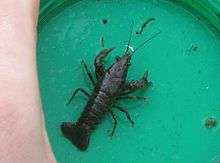Orconectes virilis
| Orconectes virilis | |
|---|---|
 | |
| Adult | |
| Scientific classification | |
| Kingdom: | Animalia |
| Phylum: | Arthropoda |
| Subphylum: | Crustacea |
| Class: | Malacostraca |
| Order: | Decapoda |
| Family: | Cambaridae |
| Genus: | Orconectes |
| Species: | O. virilis |
| Binomial name | |
| Orconectes virilis (Hagen, 1870) [1] | |
Orconectes virilis is a species of crayfish known as the virile crayfish, northern crayfish, Eastern Crayfish and lesser known as the Lake Crayfish or Common Crawfish. It is native to eastern United States and southeast Canada.
Ecology
Orconectes virilis can be found under stones in lakes, streams and wetlands, where they hide from predators, such as fish. They are identified by the brown of rust-red carapace and large chelipeds, which are usually blue in colour. Orconectes virilis feeds on a wide range of plants and invertebrates, as well as tadpoles and even small fish.
Distribution

Orconectes virilis is found in southern Canada from Alberta to Quebec and in the northern United States, but has become an invasive species in parts of North America outside its native range, and was discovered in the United Kingdom in 2008.[2] It is listed as a species of Least Concern on the IUCN Red List.[3]
Uses
Orconectes virilis is used as fishing bait and as food for humans, and also as aquarium food for carnivorous fish.[4]
References
- ↑ "Orconectes virilis". Integrated Taxonomic Information System. Retrieved October 20, 2010.
- ↑ Daniel Ahern, Judy England & Adam Ellis (2008). "The virile crayfish, Orconectes virilis (Hagen, 1870) (Crustacea: Decapoda: Cambaridae), identified in the UK" (PDF). Aquatic Invasions 3 (1): 102–104. doi:10.3391/ai.2008.3.1.18.
- ↑ S. Adams, G. A. Schuster & C. A. Taylor (2010). "Orconectes virilis". IUCN Red List of Threatened Species. Version 3.1. International Union for Conservation of Nature. Retrieved October 20, 2010.
- ↑ Krista Kagume (2008). Ontario Nature Guide. Edmonton: Lone Pine Publishing. ISBN 1-55105-564-3.
External links
- "UK Crayfish Website". Buglife – The Invertebrate Conservation Trust.
